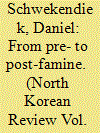| Srl | Item |
| 1 |
ID:
079890


|
|
|
|
|
| Publication |
2007.
|
| Summary/Abstract |
Child malnutrition is the most pressing problem of the world, damaging to both children and nations. Malnutrition is costing poor countries up to 3 per cent of their yearly GDP. The pessimistic scenario suggests that child malnourishment will increase from 166 to 175 million children by 2020. Therefore, a detailed analysis of the plight of these children, and the root causes of malnutrition, are of paramount importance. The underlying causes of undernutrition vary from poverty, low levels of education and poor access to health services. The high levels of undernutrition in children and women in South Asia and Sub-Saharan Africa pose a major challenge for child survival and development. The examples of Thailand, Vietnam and China show that the problem of malnourishment is entirely preventable. Areas of intervention that will be most successful and the key policy priorities for each major developing region need to be identified.
|
|
|
|
|
|
|
|
|
|
|
|
|
|
|
|
| 2 |
ID:
124585


|
|
|
|
|
| Publication |
2013.
|
| Summary/Abstract |
Purpose-In the 1990s, North Korea experienced a national crisis that evolved into a famine. This paper explores the trends in underweight among preschool children measured from the pre- to the post-famine period.
Design-This research employs nutrition surveys carried out in North Korea in 1987, 1997, 1998, 2000, 2002, 2004, 2009 and 2012.
Findings-This paper shows that the country now has reached a pre-crisis level, indicating that children today are faring as well as they were during the Cold War. However, underweight rates are 24 times higher in North Korea compared to South Korea. More important, the UN targets an underweight rate of 9 percent in East Asia, but the rate is as high as 15 percent in North Korea, implying that further efforts are needed.
Originality-This paper provides rare evidence on the long-term trend in underweight among North Korean children. This is also the first paper that compares underweight rates of contemporary North Korean children with their South Korean peers.
|
|
|
|
|
|
|
|
|
|
|
|
|
|
|
|